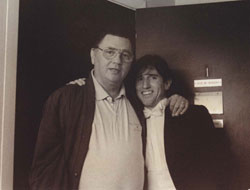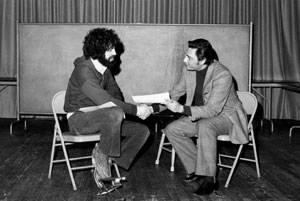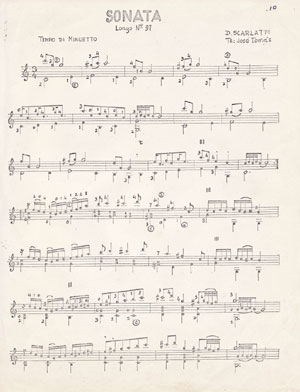Howard Bass began studying classical guitar as a teenager in Cleveland, Ohio. He continued his studies with John Marlow in Washington, D.C., and with José Tomás in Alicante, Spain. Now primarily a lutenist, he performs and records with Trio Sefardi and mezzo-soprano Barbara Hollinshead. He has also performed and recorded with La Rondinella, HESPERUS, the Smithsonian Chamber Players, the Folger Consort, the Baltimore Consort, and the Choral Arts Society of Washington, among others.
In the 1950s anyone who knew anything about classical guitar knew one name: Andrés Segovia. By the 1960s, the immensely engaging English lutenist and guitarist Julian Bream was touring the U.S. and Europe, and Australian phenom John Williams had begun his illustrious career. Half a century later, the proliferation of superb guitarists - and, not coincidentally, superbly crafted guitars - is nothing short of astounding. In the middle of the 20th century, however, if you wanted to study guitar your choices were few: Segovia master classes in Spain and Italy, a handful of conservatories, mostly in Europe, private study with teachers who may have been just a few steps above beginning level themselves. Nowadays most U.S. and European conservatories and a great many colleges and universities offer classical guitar study, and even guitar pedagogy, at the undergraduate and graduate level.
The seeds of interest and enthusiasm that Segovia, Bream, and Williams sowed in the middle of the 20th century have borne an amazing harvest. Among those who helped foster this interest was José Tomás, a guitarist of great skill and discernment whose name and reputation may not resonate with the general public, but whose legacy as a teacher is firmly fixed among a generation of guitarists, and not a few lutenists.
José Tomás Pérez Sellés (August 26, 1934 - August 7, 2001) was born and lived his entire life in the Spanish port city of Alicante, Spain, on the Costa Blanca, south of Valencia. Alicante is a jumping off point for the Balearic Islands - Mallorca, Ibiza, Formentera among them - which made the city a destination (or, rather, a pass-through point) for a good many free-spirited young people from the world over in the heady days of the 1960s and 70s. The city also has long been a favorite vacation spot for Madrileños and a lively port-of-call for the U.S. Navy. But for some, it was the presence of José Tomás that made Alicante attractive, although inexpensive and tasty paella, cheap red wine, and easy access to Mediterranean beaches didn't hurt. Tomás's apartment on Calle Taquígrafo Martí became a kind of international crossroads, and a chance to sit there facing the maestro meant the world to aspiring classical guitarists.
Tomás was not from a musical family, but after hearing a guitarist play at the home of a friend, his interest was piqued and his course in life was set. His first guitar teacher was Rafael Balaguer in Valencia, and he went on to study with Regino Sainz de la Maza and Emilio Pujol. In 1958 and 1959 he participated in master classes with Segovia in Siena, Italy, and at Música en Compostela (Spain). His association with Segovia as a student and later as an assistant teacher and director at the annual master classes in Santiago de Compostela brought Tomás to the attention of the guitar world. While Segovia continued to teach occasionally at Música en Compostela, Tomás was named director in 1964, a post he held for seventeen years. Tomás would typically arrive in Santiago de Compostela a week before Segovia, and he would listen to and evaluate students who wished to participate in the master classes.

Andrés Segovia, Larry Snitzler, José Tomás in Santiago de Compestela, 1963, courtesy of Larry Snitzler.
As much as Tomás loved Spanish music, he was particularly passionate about Renaissance and baroque music, including Bach's lute suites, the music of lutenist/composer Sylvius Leopold Weiss, and the harpsichord sonatas of Domenico Scarlatti. Tomás was frustrated by the guitar's limited bass range, so he asked José Ramirez III to build a guitar with two additional bass strings, giving him the freedom to play most bass lines in their original configuration.
By the early 1970s several of Tomás's students began to play 8-string guitars, which was no doubt gratifying to Tomás, but also caused him some apprehension as the time for the annual Música en Compostela master class approached. Andrés Segovia had little use for modern innovation where the classical guitar was concerned. For Segovia, the classical guitar ethos mainly featured six strings (nylon, to be sure, but still...), one guitar (though he did admire the playing of the Presti-Lagoya duo), and compositions he transcribed or were dedicated to him. Deciding to face the problem head-on, Tomás placed three of his students with 8-string guitars at the top of the list to play for Segovia. Nervously, Tomás awaited Segovia's reaction as the first player performed, but Segovia confined his comments to interpretation. Then the second player performed, and there was still no reaction from the great maestro. As the third student approached with his 8-string, Segovia, with a mix of resignation and noblesse oblige, turned to Tomás and remarked, in his rich, sonorous voice: "You have too many disciples."
When I told Larry Snitzler this story, he recalled that Segovia had remarked to him that Tomás's 8-string guitar was "not a bad thing," and that he was not totally against it. On the other hand, Segovia took a very dim view of the 10-string guitar that Narciso Yepes played. Segovia thought that Yepes's innovation made the guitar "look ugly," and he also objected to the ringing of the extra bass strings. For Segovia, the 8-string did maintain the kind of visual symmetry that he cherished, but clearly the 10-string violated it.
While José Tomás is remembered today for his influence as a teacher, he was a fine performer in his younger years. In 1961 he was the first-prize winner at Segovia's guitar competition in Orense, Spain, and he possessed the technical, tonal, and interpretive skills that might have made him a logical successor to Segovia on the international concert stage. But temperamentally he was not well-suited to the life of a performer. He loved being home in Alicante, and he confided to students that he much preferred his wife's cooking to anyone else's. Indeed, the rich aromas from the kitchen that competed with thick cigarette smoke in the apartment on Calle Taquígrafo Martí made a convincing case for this point of view.

José Tomás and Ignacio Rodes at el Teatro Principal de Alicante following a recital by Rodes, 1998, courtesy of Ignacio Rodes.

Howard Bass and José Tomás, Washington, D.C., 1973, courtesy of Howard Bass.
Tomás's presence in Alicante, and his willingness to accept private students in his home, drew classical guitarists from the world over, among them the Scottish guitar virtuoso David Russell. Russell wrote of Tomás, "He was definitely my most important teacher, although I met him at the end of my studying years [in the mid-1970s]. He was inspiring, knowledgeable, and gave me a sense of belief that I had not received from other teachers. He had the ability to simplify the problems and organize the solutions, both in practice and in his teaching." Ignacio Rodes adds, "His teaching techniques were very modern although [they] followed the tradition of the Spanish school, with special attention to Fernando Sor. For me, he had the musical concept of a conductor and was able to analyze extremely well every aspect related to the work you were playing. On the other hand, he was very strict with the necessity of choosing works from the guitar repertoire of the highest musical level." For his part, Tomás, speaking to guitarist Larry Snitzler, called David Russell "the most talented student I ever had." He went on to say, "I consider it a privilege that in my lifetime I should have such a student."
Dana Chivers, who came to Alicante as a relative beginner, says that he felt that Tomás lacked a cohesive plan of study. It's likely that his thinking about guitar pedagogy was still evolving in the early 60s, and that he was less rigorous in some ways with students who worked with him outside of the conservatory setting. On the other hand, Chivers says he remembers that Tomás "loved to discuss (even with me) different possibilities of interpretation. That certainly attested to an open mind." My own lessons with Tomás were almost all about interpretation, and much of what I learned while working with him during my first stint in Alicante - Bach, Frescobaldi, Ponce, Tedesco - was incorporated into my senior recital in the fall of 1969.
Larry Snitzler cites Tomás's clarity about options - meaning the exploration of every possible solution to a given fingering problem - and his emphasis that players needed to acquire a thorough understanding of the fingerboard. Even though some fingering possibilities may not be viable, Tomás believed, once in a while one will discover a new and unexpectedly successful way to play a challenging section. Snitzler also says that Tomás once spoke to him of a way to understand Spanish music that has resonated for him ever since. Spanish music, Tomás said, is characterized by rapid, often abrupt shifts between moods of emotional lyricism and suppleness to passages that demand, more than anything, rhythmic precision. For Larry Snitzler, this statement opened the way for a new appreciation of how to approach Spanish music, a particularly useful tool for a non-Spaniard.

Scarlatti transcription by José Tomás, courtesy of Howard Bass.
Tomás knew and worked with the Alicante-born composer Óscar Esplá (1886 - 1976), for whom the Conservatorio Superior de Alicante is named. He transcribed two movements of Esplá's Suite Levantina (composed for piano), as well as a previously unknown work called "Tempo di Sonata," composed in 1920. Ignacio Rodes relates an interesting if somewhat confusing story about this piece. Sometime in the 1920s, Esplá showed this work to Segovia in hopes that Segovia would perform it. Upon examining the music, Segovia said it would be impossible to perform on the guitar without alterations, which Esplá refused to make. In anger (or frustration), Esplá tore the page from the manuscript, later writing "Tempo di Sonata for chromatic harp" on it. Esplá had told Tomas that he had written some music for guitar, but the whereabouts of the manuscript was unknown. Following Esplá's death, Tomás was able to find and identify the "Tempo di Sonata" as the missing piece originally intended for guitar. In 1978 Tomás gave the piece its premiere performance in Alicante, and Ignacio Rodes has made the only known recording of this work.
Tomás was a wonderful sight reader, a skill not common enough among guitarists, and one that
must have helped him immensely as he explored music suitable for transcription. Dana Chivers remembers Tomás "on his red couch in the sitting room reading through reams of Weiss and many others; Scarlatti must have come later." Chivers also recalls that while he was studying in Alicante Tomás received a manuscript of Mario Castelnuovo-Tedesco's suite, "Platero y Yo." "Tomas, while I sat enthralled by this beautiful music, read most of the score in one sitting."
Tomás visited Japan a few times, and some of his music was published there. As testament to his affection for Japan, he often wore a silk Japanese robe when teaching (at his home, that is). The room where he taught was typically rather dark, with heavy curtains drawn to block the intense Mediterranean sunlight. Tomás would enter and acknowledge his student, then sit on the couch facing the student, light up a cigarette, and ask, "What have you done?" This took some getting used to, especially for students who may have spent a bit too much time curled around a wine bottle and not around the guitar, but he wasn't judgmental. Tomás was quiet, soft-spoken, calm - at least on the surface - and, as Dana Chivers described him, "seemingly humble." Bo Leyden describes an incident at a concert by David Russell: "Once at a concert south of Alicante set up for David Russell as a 2nd place prize for him for his phenomenal playing of the competition piece by Tedesco in the Alicante competition, an audience member came in after the concert had begun and let the door slam. Russell looked up but kept playing without missing a beat. Tomás, at the end of the piece, got up and went into an impassioned speech addressing the inconsiderateness of that person and the disruption to the artist and the flow of the music. It was all in Spanish but I got the drift. He was red in the face with anger about the interruption. He was pretty high strung, I would say, but had a great sense of humor."
María Jesús Rodríguez, who, in addition to being a guitarist, is David Russell's wife, writes, "We both have very fond memories of José Tomás. He was important in our relationship with the instrument and in our development as musicians. We also remember with affection the time we shared with him socially. He was an enjoyable person, full of wit and, as we had so much admiration for him, we were always happy to spend time with him." Dana Chivers also points to another of Tomas.s strong interests, the game of chess. "For us, the foreign students, playing chess was our second passion. Once he actually lost a game to me. He didn't like that very much. It was just luck on my part! But I do remember him saying that playing chess was like technique; totally logical."
The attention to detail that was so evident in his transcriptions - as well as his sense of humor and capacity for enjoyment of other things in life (in addition to food) - was revealed as Tomás grew more comfortable around me. At one of my lessons we must have been discussing something about the physical nature of guitars when he decided to show me the design he'd made for his ideal guitar. He produced a graph-paper notebook and opened it up to a drawing, minutely rendered, of something that resembled a guitar. As I recall, it was somewhat different in shape, more square then curved. The back was concave to accommodate the guitarist's protruding stomach. There was a drawer with room enough for a sandwich in case the performer got hungry while playing. There were also two electric lights, one red, and the other green. When the player was approaching a difficult passage, the red light would illuminate to alert the audience; if the passage was performed cleanly, the green light would go on, presumably inducing cheers and good feelings among the listeners.
On another day, as I was leaving his apartment after my lesson, Tomás said he wanted to show me something in his study, which was adjacent to the living room where he received his students. The study was crammed with manuscripts, instruments, and books; on entering I assumed he wanted to show me some music or an instrument. Not so. He walked to one of the walls on which was mounted a large piece of plywood, probably 4 ft. by 8 ft., which was cleverly hinged to the wall. He unhooked the top and lowered it to the horizontal, revealing a complete scale-model village, like the kind of model train set-up many of us had as youngsters. But instead of train tracks, Tomás's set-up was traversed by slot-car tracks. He produced a couple of slot-cars and got them running around the tracks at high rates of speed; gone, for a moment, was the quiet, serious maestro, replaced by a fun-loving kid-at-heart. I don't know why he decided to show his slot-car set-up to me, but I was grateful for this glimpse of his other side, his other interests. The attention to detail in what was obviously a pastime was as clear as in any of his Bach or Scarlatti transcriptions.
Tomás's life ended, as it began, in the city of Alicante. His health began to fail in his later years; he underwent triple by-pass surgery, and a series of strokes took their toll. He had held the post of professor of guitar at the Conservatorio Superior de Música Óscar Esplá for two decades; his former student, Ignacio Rodes, has held that position since 1998. The position of Conservatorio Profesional de Música "Guitarrista José Tomás" is named in his honor, as is an international classical guitar competition, the Concurso Internacional de Guitarra Clásica "José Tomás - Villa de Petrer." He and his wife, Lolita, had three children, Paco (Francisco), Lola (Maria Dolores), and Maria Luisa, none of whom has followed their father's musical interests.

José Tomás's only recording (1968), courtesy of Ignacio Rodes.
Howard Bass, March 2012
Many thanks to David Russell, María Jesús Rodríguez, Ignacio Rodes, Bo Leyden, Larry Snitzler, and Dana Chivers for their time and generous contributions to this article, and to Sheldon Pollock and Lisette Voyatzis for editorial assistance.